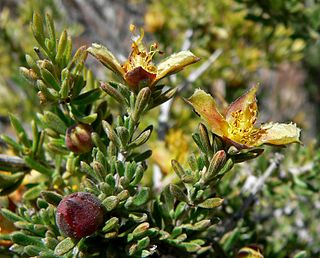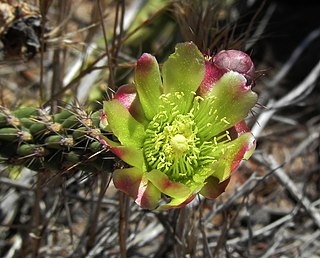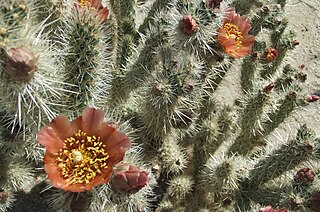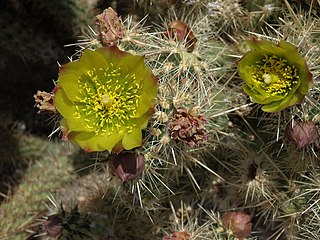Description
Cylindropuntia ramosissima is a decumbent or erect and treelike cactus which can approach 2 meters-6 feet in maximum height. It has many narrow branches made up of cylindrical segments, green in color drying gray, the surface divided into squarish, flat tubercles with few or no spines, or often with a single long, straight spine.
The flower is small and orange, pink or brownish in color. The fruit is a small, dry, spiny body up to 2 centimeters long.
Cylindropuntia ramosissima is a host to several species of moths, most notably the Sphinx Moth.

Cylindropuntia fulgida, the jumping cholla, also known as the hanging chain cholla, is a cholla cactus native to Sonora and the Southwestern United States.

Cylindropuntia bigelovii, the teddy-bear cholla, is a cholla cactus species native to Northwestern Mexico, and to the United States in California, Arizona, and Nevada.

Cylindropuntia imbricata, the cane cholla, is a cactus found in the Southwestern United States and northern Mexico, including some cooler regions in comparison to many other cacti. It occurs primarily in the arid regions of the Southwestern United States in the states of Kansas, Oklahoma, Texas, New Mexico, Arizona, Colorado, and Nevada. It is often conspicuous because of its shrubby or even tree-like size, its silhouette, and its long-lasting yellowish fruits.

Cylindropuntia is a genus of cacti, containing species commonly known as chollas, native to northern Mexico and the Southwestern United States. They are known for their barbed spines that tenaciously attach to skin, fur, and clothing. Stands of cholla are called cholla gardens. Individuals within these colonies often exhibit the same DNA, as they were formerly tubercles of an original plant.

Grusonia is a genus of opuntioid cacti, originating from the North American Deserts in Southwest United States and northern Mexico, including Baja California. Authors differ on precise boundaries of the genus, which has been included in Cylindropuntia. Corynopuntia, also known as club chollas, is now a synonym, with the genus originally being described by Knuth in 1935. Molecular phylogenetic studies suggest that it should be included in Grusonia, a view accepted by Plants of the World Online as of June 2021.

Echinocereus engelmannii, the strawberry hedgehog cactus or Engelmann's hedgehog cactus, is a cactus commonly found in desert areas of the southwestern United States and the adjacent areas of Mexico, including the states of California, Nevada, Utah, Arizona, Baja California and Sonora.

Coleogyne ramosissima or blackbrush, is a low lying, dark grayish-green, aromatic, spiny, perennial, soft wooded shrub, native to the deserts of the southwestern United States. It is called blackbrush because the gray branches darken when wet by rains. It is in the rose family (Rosaceae), and is the only species in the monotypic genus Coleogyne.

Cylindropuntia echinocarpa is a species of cactus known by the common names silver cholla, golden cholla, and Wiggins' cholla. It was formerly named Opuntia echinocarpa.

Grusonia parishiorum is a species of cactus known by the common names matted cholla and Parish club cholla. It is native to the Mojave and Sonoran Deserts of California and Arizona.

Cylindropuntia californica is a species of cholla cactus known by the common name snake cholla. It is primarily found in Baja California, Mexico and the southernmost part of California in the United States. It is characterized by a short, decumbent habit, yellow-green flowers, elongated stems, and short spines. It is mostly found in coastal sage scrub and coastal chaparral habitats, but two varieties in Baja California can be found in foothills and deserts. In California, variety californica is regarded as a rare and threatened plant, with a California Native Plant Society listing of 1B.1, in part due to its limited number of occurrences and threats from development. It formerly was considered to have a larger range due to the inclusion of Cylindropuntia bernardina within it as the variety parkeri.

Cylindropuntia prolifera, known by the common name Coastal cholla, is a species of cactus. In Australia it is called 'Jumping Cholla' because of it seeming to jump from outbreak to outbreak.

Cylindropuntia wolfii is a species of cactus known by the common name Wolf's cholla.

Cylindropuntia leptocaulis, the desert Christmas cactus, desert Christmas cholla, pencil cactus, or tasajillo, is a species of cholla cactus.
C. californica may refer to:
C. ramosissima may refer to:

Cylindropuntia spinosior, with the common names include cane cholla, spiny cholla and walkingstick cactus, is a cactus species of the North American deserts.

Cylindropuntia whipplei is a member of the cactus family, Cactaceae.
Cylindropuntia abyssi, common name Peach Springs cholla, is a species of cactus endemic to northwestern Arizona. It is known from only from the Grand Canyon and in Peach Springs Canyon, on the Hualapai Reservation in Mohave County. It grows in desert scrub on limestone ledges and hilltops. The natural range of the species is fairly small, but it is locally abundant and growing in an isolated area with few threats to the species survival.

Cylindropuntia fosbergii is a species of cactus known by the common names Hoffmann's teddybear cholla, pink teddy-bear cholla, and Mason Valley cholla. It is endemic to south-eastern California where its range is restricted to the flats and hillsides of a very limited area in the region of Anza-Borrego Desert State Park in the western Sonoran Desert.

Cylindropuntia bernardina is a species of cholla cactus commonly known as the cane cholla or valley cholla, native to California and northwestern Baja California. It is an erect cholla that grows up to 2–3 meters tall, and occurs primarily in the foothills of the Transverse and Peninsular Ranges, parts of the Sonoran Desert, and in the Coast Ranges with a few populations around the Cuyama River. It was formerly placed as the variety parkeri of Cylindropuntia californica until it was renamed to C. bernardina. It is more closely related to Cylindropuntia ganderi than to C. californica.

















